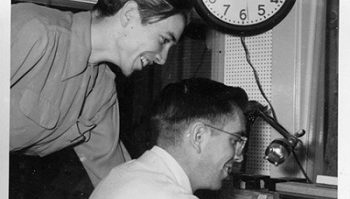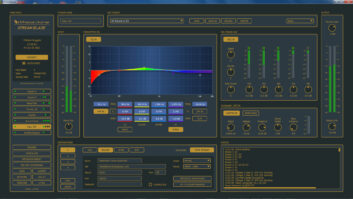
Weston type 30, model 862 vu indicator with ‘B’ scale on RCA OP-6 portable amplifier. A Daven resistor network reduced the output from +11 dBm to telco-required +8 for 3 dB line isolation, sent the proper voltage to the meter, provided the 3k9 buildout, and also created an output Z of 150 ohms to improve frequency response on feeding telco lines. Two No. 47 frosted lamps mounted below the glass illuminated the scale. Once upon a time, three wise men (no, not the ones you’re thinking of; these guys were from NBC, CBS and AT&T) came to call on John Miller, vice president and chief engineer of Weston Instruments in New Jersey (which to some may be The Holy Land).
There, the trio complained that the “dB” indicator that all broadcasters had been using had many serious drawbacks, which they went on to list.
First, the indicators were designed so that a meter could be used on either 500- or 600-ohm program lines, which are not the same. It indicated 1.73 V at “0” on the scale on 500-ohm lines (used in motion picture sound recording), but it needed 1.9 V to do it on 600-ohm broadcast lines.
Not only was the scale’s range a scant 16 dB, but the zero mark was reached before midpoint on the scale, thus wasting more than half of the scale area. The meter’s resistance was so low — 5k-ohms at “0,” dropping to only 1774 ohms at program levels of –9 dB — that it loaded the line it was supposed to bridge.
Then there was the fact that the pointer moved too fast, indicating peaks that the movie boys liked for optical recording, but which masked the average program level monitoring required by broadcasters.
Added to this was the high contrast of the black-on-white scale, which made for rampant operator eye fatigue. Not only were the meters frequency-sensitive, they were also inaccurate at voltages other than whatever was required to move the pointer to “0.”
Adding insult to injury, it took too long for the pointer to settle down to proper power indication from its overshoot. What a mess!
Righting wrongs
Miller took on the task of fixing all of this, and lo, 75 years ago the vu indicator came to pass.
I say “indicator” because what we call a “meter” is not one (the indicator of electricity consumption at our homes is a meter). But with this revolutionary industry standard came an obligation: You have to hook it up right, or it won’t be accurate.
And you can’t put “vu” scales on AC voltmeters and expect them to give you indications you can rely on, nor any other true vu meter’s benefits. You mustn’t use them on lines other than those with a net impedance of 300 ohms (600-ohm source to 600-ohm load).
And here are things you don’t know about these indicators:
1.Although not in the NSA spec, “vu” should be written in lower-case letters
2. While not mandatory, the “A” scale (vu indications predominant) is only for use on test equipment and limiters, while the “B” scale (percent modulation indications above the arc) is for everyday program level monitoring.
Incidentally, why is it that we don’t find meters with “B” scales in any studio today?
Well, blame Ray Dolby for that. You see, in the 1950s, when Dolby designed the circuit for the early Ampex tape recorders, he knew little about vu meters and broadcast/recording practices. So he figured that the vu scale (used just when calibrating the recorder) should be predominant.
From that moment on, virtually every broadcast and recording equipment maker (save, perhaps, RCA, Gates, Collins, Sparta) and recording studio operator (except yours truly) repeated Ray’s mistake.
Weston referred to dB meters as power indicators (6 mW power at “0”) and to vu meters as “volume” indicators. But as volume is construed to denote power, vu meters will indicate 1 mW at 0.7746v when the pointer is at –4 vu, and 1.228v when the pointer is at “0” (100% on the percent modulation scale).
The percent-modulation scale indicates percent power and percent voltage; ideal for studio and transmitter use. What’s a volume unit? It’s numerically equal to the number of decibels above or below 1 mW. Thus the term “volume unit” (coined by Miller) can’t apply to a dB meter designed for 6 mW lines, nor can it apply to any pseudo vu meter.
The result of Miller’s new design, based upon a DC microammeter with a carefully selected rectifier (probably made by Conant) was the 1938 introduction of this radically different volume level indicator, which has stood the test of time under its “street” name: vu meter.
That’s one beautiful meter!
Let’s see how carefully it was crafted. You’ll see that it’s truly ingenious.
It has an impedance of 3k9 ohms when a 1 kHz signal pushes the pointer to “0” (4 dB above 1 mW). But it must be used with a 3k6 resistor in series. While reducing line loading, this minimizes the unavoidable impedance change with signals other than 1 kHz and 1.228 volts.
But there’s a major characteristic that makes the meter the gem that it is: It must see its own impedance. Is a 3k9 instrument seeing its own impedance via the 3k6 buildout resistor? Of course not. Yet don’t forget the 300 ohm (600/600) program line, which added to 3k6 gives 3k9, matching the meter’s 3k9. QED.
Please bear in mind that without this impedance matching, the meter will not be accurate. Even a real, standard vu meter will not be accurate without matching.
What else did Miller do for the radio guys? He damped the meter so as to minimize overshoot (the purpose of damping), which also slowed the pointer action so that the meter reads average program levels not masked by occasional peaks.
The zero point on the scale is far right of center, permitting maximum scale utilization, and its range was increased to 23 dB. He further improved legibility and reduced eye fatigue by specifying a buff color (yes, it’s in the spec), and by creating a scale where overvoltage readings are in red.
Another benefit is that the meter and build-out resistor, totaling 7k5 ohms, met the desired 12.5 times the program line’s impedance for minimum line loading. Myriad parameters had come together in a perfect fit. Many meter makers began offering vu meters after the advent of Weston’s Type 30 series.
Most of these companies, including Weston, no longer exist. What came closest to Weston’s in styling was made by Simpson. Other meter makers were Assembly Products, Burlington, Marion, Dayton, Beede, Hoyt, Selco, Modutec (though the Triplett’s I tested didn’t meet spec).
One meter dealer merits a mention. It’s Metercraft of Santee, Calif. Not only are they dealers, but they did a marvelous job salvaging the “irreparable” Weston pictured here. Applause!
DIY
Want to add a vu meter to your mixer? Easy. Terminate that lo-Z unbalanced output with a 300-ohm resistor. Then place a standard meter having a 3k6-ohm resistor in series with it across the 300-ohm resistor and voila! You’ve done it. Your volume indicating will be accurate, easy on the eyes and legible.
Stop relying on flashing lights. You’ll now have a traditional broadcast-standard zero-level-line. And don’t forget what the manufacturers don’t tell you: Only a factory-adjusted meter can be used on steel panels or within two inches of a ferrous metal.
Finally, don’t expect a meter with an expanded scale to be a true vu meter unless all specs have been met and practices adhered to.
One unfortunate aspect of the vu meter, which didn’t matter at the time and rarely does today, is that the meter’s frequency response rolled off at 10 kHz. At the request of a major recording studio products maker, I recently tested a Chinese vu meter he’d been using in a limiter. It flunked all tests save one: It was flat to 100 kHz.
My favorite “uses and abuses of the vu meter” story happened many years ago. A famous beauty products maker, Charles Antell Co., bombarded national audiences with a TV commercial for a new shampoo. We saw a woman’s head, above which was her hairdresser’s arm, holding a light meter to prove how bright the lady’s hair became after a Charles Antell shampoo.
I sent a note to The Hollywood Reporter, advising gossip columnist Mike Connolly about this sham. Connolly soon wrote, “Oliver Berliner says the light meter used in the Charles Antell commercial is actually a Simpson model 142 vu meter.”
Charles Antell quickly pulled the spot.
Oliver Berliner is a self-styled leading authority on uses and abuses of the vu meter. Reach him at [email protected] on this or any story. Write to [email protected].












